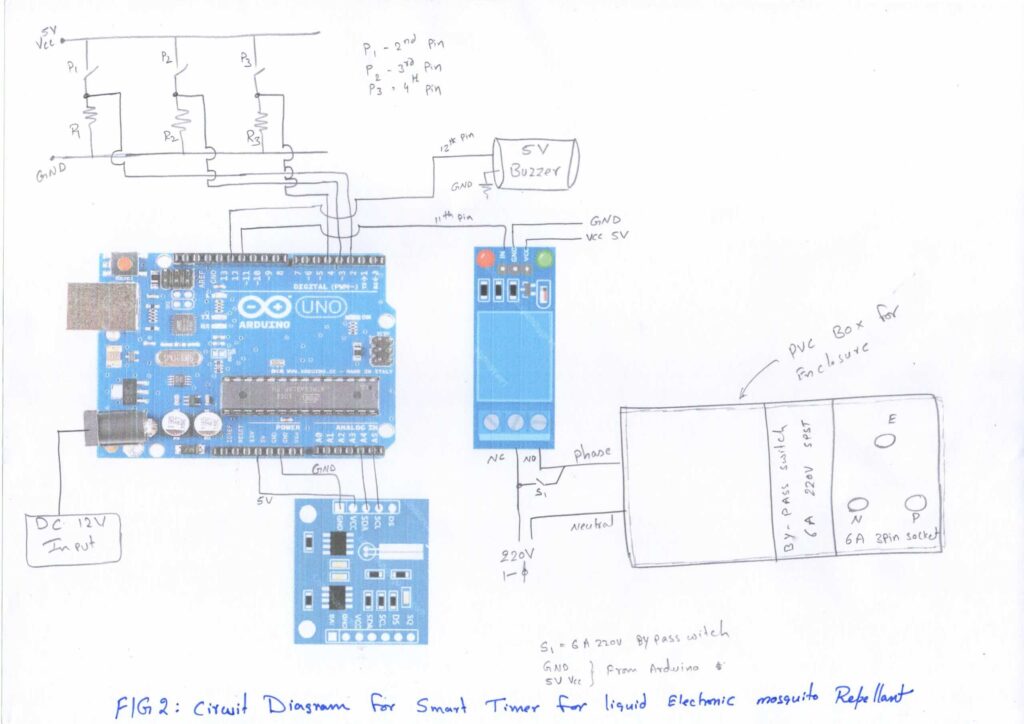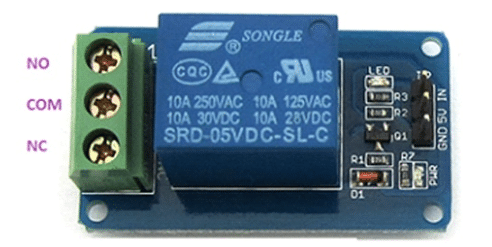[ad_1]

As the dangerous hazards of mosquitoes are increasing day-by-day, the usage of liquid electronic mosquito repellents is increasing day by day. Liquid Electronic mosquito repellents are used widely for a good night’s sleep and are also commonly used in offices for a better day’s work. Inhalation of mosquito repellent vapour is causing harmful breathing effects and allergic reactions. Most liquid electronic mosquito repellents are rugged in construction and operate continuously as their switched on.
The continuous operation of the liquid electronic mosquito repellent continuously vaporises the liquid which the content of the vapour in the room exponentially increases with time. Here we introduce smart timing operation for the liquid electronic mosquito repellent which contains different modes of operation suitable for all residential and office purposes.
Circuit and Working
The block diagram of the smart electronic mosquito repellent timer is shown in the figure 1. The block diagram mainly consists of the arduino board which is the heart of the system , centred around ,the real time clock, the mode selection switches and a 5 volt relay board. The main idea of the timer is to switch ON and OFF the liquid electronic mosquito repellent according to different modes of operation. Here for convenience we have taken 7 different modes which are selected by the three selection switches.

Mode 1: Night mode:
This is the general purpose mode, where most most of the household during night uses it , for undisturbed sleep. In this mode, the controller automatically switches on the mosquito repellent between 18:00hrs. And 6:00 a.m. Continuously without any interruption. It automatically switches OFF after 6:00 a.m. Most often times, we switch OFF the repellent at different irregular times which is feasible to us. This habit causes the exhaust of the liquid and also unnecessary vapour into the room.
Mod 2: Night toggle mode
In this mode, the timer switches on the repellent continuously from 18 hrs. to 00:00 Hours. Later it toggles from 00:00hrs to 6:00 a.m. On hourly basis. In the evening the doors are opened and closed very often, so there is a lot of need of the vapour in the room to kill the mosquitoes.
Due to this continuous operation of the repellent the vapour in the room increases exponentially. The high vapour concentration in the room is not required during the late night hours. After late night hours ie: After 00:00 hrs the repellent is switch ON and OFF on hourly basis up to 6:00 a.m. In the morning. The toggling of repellent after late night hours reduces the concentration of the vapour and protects us from inhaling the vapour excessively
Mod 3: Night toggle mode with buzzer
This mode is similar to Mode 2 operation. The additional feature of this mode is that it ends up with a buzzer which acts as a wake-up alarm.
Mode 4: office Mode
This mode is used when the mosquito repellent is used in offices. It switches on continuously during the office hours between 10:00 a.m. To 18:00 hrs. Rest of the time it is switched OFF. This mode is used in opened office rooms ( doors open ).
Mod 5: Office toggle mode
In this mode, the repellent is switched ON and OFF on an hourly basis during the office between 10:00 a.m. and 18:00 hrs. This mode is mostly used in closed air-conditioned office rooms.
Mode 6: Hall mode
This mode is generally used in a halls, where the family gather during evening times in residential houses. The timer switches on the repellent between 17:00 to 22:00.
Mode 7: all day toggle mode
This mode works all the day, 24 hours with a non-continuous operation. In this mode, It switches ON and OFF the repellent on hourly basis. This mode is generally used in office rooms which work 24 / 7
The 7 modes are controlled by these switches p1 P2 P3 as shown in Figure 2. The switches are simple SPST switches connected in series with the resistor between the 5 volt and the ground pin of the Arduino board. The output of the switches are connected to the audio board pins which are shown in table 1. The position of the switches and the corresponding modes of operation are shown in table 2.

The controller needs the timer input for comparison with the set times. For this operation DS 1307 I2C RTC module is used and shown in Fig 3.
This module keeps the clock running. The DS1307 serial real-time clock (RTC) is a low-power Battery-Backed by lithium CR 2032 3Volt, and the data ( seconds, minutes, hours, day, date, month, and year information) are transferred serially through an I2C, bidirectional bus. Apart from the power supply, only TWO pins SDA (data line) and SCL (clock line) are required for establishing the I2C communication. The pin connection to the I2C module and to the Arduino board are shown in the circuit diagram.

5 5-volt buzzer is connected to pin 12 of the Arduino board. And, the ground pin of the Buzer is connected to Arduino ground.
| Table 1: Arduino UNO Pin Connections With Components | |
| Arduino UNO Pins | Components |
| 5V pin | DS 1307 I2C RTC module VCC pinConnected to VCC pin Of Relay BoardTo switches P1,p2,p3 |
| Pin 2 | Switch p1 out put |
| Pin 3 | Switch p2 out put |
| Pin 4 | Switch p4 out put |
| A4 | SDA pin of DS 1307 I2C RTC module |
| A5 | SCL pin of DS 1307 I2C RTC module |
| Pin 11 | Input signal pin Of Relay Board |
| Pin 12 | Buzzer positive pin |
| GND | Connected GND pin Of Relay BoardConnected to DS 1307 I2C RTC module GND pinConnected to buzzer GND pinResistors R1, R2 , R3, |
The Software and Code
The Circuit operation is performed through the software program loaded into the internal memory of Arduino UNO. The program/sketch is written in Arduino programming language. ATmega328P on Arduino UNO comes with a pre-programmed boot loader that allows users to upload a new code to it without using a peripheral hardware programmer.
Arduino IDE is used to compile and upload the program. The sketch is the heart of the system and carries out all major functions. The program is easy and simple to understand. Comments are given at the end of each command line. Input and output pins are initialised. The following functions and libraries are used.

Serial.begin(): Establishes serial communication between Arduino UNO board and another device, via a USB cable. It permits the two devices to communicate using a serial protocol. Here serial communication is used only to just read the data from Arduino UNO onto the screen. The displayed data allows us to know the time, and working mode
In this project, the following header files are used in the main code.
#include <Wire.h>. The Wire library allows to communicate through I2C devices, also called “2 wire” or “TWI” (Two Wire Interface). The SDA (data line) and SCL (clock line) are used for communicating with DS1307 RTC Module.
#include “RTClib.h”. Used For communicating with the DS1307 RTC module.
In the next step , initialize the relay and ISD1820 MODULE P-L PIN as output.
Serial.begin(9600); used for serial communication. To display the time on the serial screen.it is used for just reference purpose.
Two methods of setting the time into the RTC module:
Method 1:
rtc.adjust(DateTime(F(__DATE__), F(__TIME__))); This line sets the time according to your computer time. It will set the present clock time of your system in to the DS 1307 I2C RTC module.
Method 2:
rtc.adjust(DateTime(2021, 7, 21, 10, 0, 0)); This command will set the time into the RTC module in this format ( year, month, date, hours, min, seconds.) (ie 2021, JUL, 21, 10:00:00 am). Once the time is set, the backup battery in the RTC module keeps the time for a very long time.
You can view Table 2: here
Precautions
The Arduino UNO boards are highly sensitive. Handle carefully.
Check the DC power supply jack input polarity ( 2.1mm center-positive plug into the board’s power jack).
Parts List
ARDUINO UNO board
DS1307 RTC Module
5V Relay module
Jumper wires
Mini breadboard
R1,R2,R3 -10k ohm
P1,p2,p3- spst switches
S1 electrical 6A switch
12V DC power supply with 2.1mm center-positive plug
K. Murali Krishna presently working as a junior engineer ( telecom systems ) installation and CDOT cards repair center, BSNL, Rajahmundry Andhra Pradesh. He is an electronics enthusiast, circuit designer and technical article writer.
Source link



